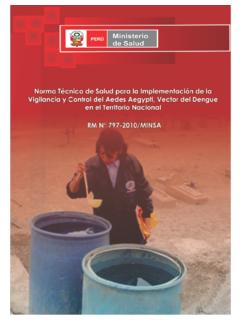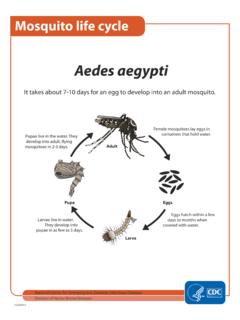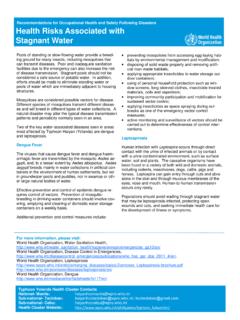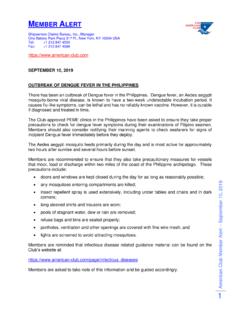Transcription of Dengue and the Aedes aegypti mosquito
1 Dengue and the Aedes aegypti mosquito The Aedes aegypti mosquito can transmit the viruses that cause Dengue fever. The female mosquito lays eggs in containers with water and plants near the home. It bites people and animals. This species can survive year round in tropical and subtropical climates. General information Aedes aegypti is a small, dark mosquito with white lyre shaped markings and banded legs. They prefer to bite indoors and primarily bite humans. These mosquitoes can use natural locations or habitats (for example treeholes and plant axils) and artificial containers with water to lay their eggs. They lay eggs during the day in water containing organic material ( , decaying leaves, algae, etc.)
2 In containers with wide openings and prefer dark- colored containers located in the shade. About three days after feeding on blood, the mosquito lays her eggs inside a container just above the water line. Eggs are laid over a period of several days, are resistant to desiccation and can survive for periods of six or more months. When rain floods the eggs with water, the larvae hatch. Generally larvae feed upon small aquatic organisms, algae and particles of plant and animal material in water-filled containers. The entire immature or aquatic cycle ( , from egg to adult) can occur in as little as 7-8 days. The life span for adult mosquitoes is around three weeks. Egg production sites are within or in close proximity to households.
3 Aedes aegypti do not remain alive through the winter in the egg stage in colder climates. Medical importance Most frequently found in tropical and subtropical areas of the world, Aedes aegypti historically is considered to be a primary vector of viral diseases such as the Dengue fever, chikungunya and yellow fever. Habitat Aedes aegypti is extremely common in areas lacking piped water systems, and depend greatly on water storage containers to lay their eggs. Male and female adults feed on nectar of plants; however, female mosquitoes need blood in order to produce eggs, and are active in the daytime. Eggs have the ability to survive drying for long periods of time, allowing eggs to be easily spread to new locations.
4 Artificial or natural water containers (water storage containers, flower pots, discarded tires, plates under potted plants, cemetery vases, flower pots, buckets, tin cans, clogged rain gutters, ornamental fountains, drums, water bowls for pets, birdbaths, etc.) that are within or close to places where humans live are ideally larval habitats for this mosquito . This species has also been found in underground collections of water such as open or unsealed septic tanks, storm drains, wells, and water meters. National Center for Emerging and Zoonotic Infectious Diseases Division of Vector-Borne Diseases, Dengue Branch Biting Behavior Aedes aegypti bites primarily during the day.
5 This species is most active for approximately two hours after sunrise and several hours before sunset, but it can bite at night in well lit areas. This mosquito can bite people without being noticed because it approaches from behind and bites on the ankles and elbows. Aedes aegypti prefers biting people but it also bites dogs and other domestic animals, mostly mammals. Only females bite to obtain blood in order to lay eggs. mosquito Control Check your yard weekly for water-filled containers. Throw away or recycle water-holding containers that are not needed. If empty containers or large objects, such as boats or old appliances must be stored, they should be covered, turned over or placed under a roof that does not allow them to fill with water.
6 Clean and scrub bird baths and pet-watering dishes weekly and dump the water from overflow dishes under potted plants and flower pots. Check that gutters are not holding water and cover rain barrels with tight screening so that mosquitoes cannot enter. Fill tree holes and other cavities in plants with sand or soil. Check for hidden bodies of water such as wells, septic tanks, manholes, clogged drains, etc. Call the health authorities when you detect unusual numbers of mosquitoes. Avoid mosquito bites Use personal protection to avoid mosquito bites. Wear long sleeve shirts, long pants, socks and shoes when mosquitoes are most active. Apply repellents such as DEET, picaridin, oil of lemon eucalyptus or IR3535 only to exposed skin and/or clothing (as directed on the product label).
7 Do not use repellents under clothing. In addition to wearing repellent, you can protect yourself and your family by taking these precautions: Use mosquito netting over infant carriers, cribs and strollers. Install or repair window and door screens to keep out mosquitoes. Dengue Branch, San Juan, PR: For more information please contact Centers for Disease Control and Prevention 1324 Ca ada Street, San Juan, Puerto Rico 00920. Telephone: 787-706-2399. Email: Web.














